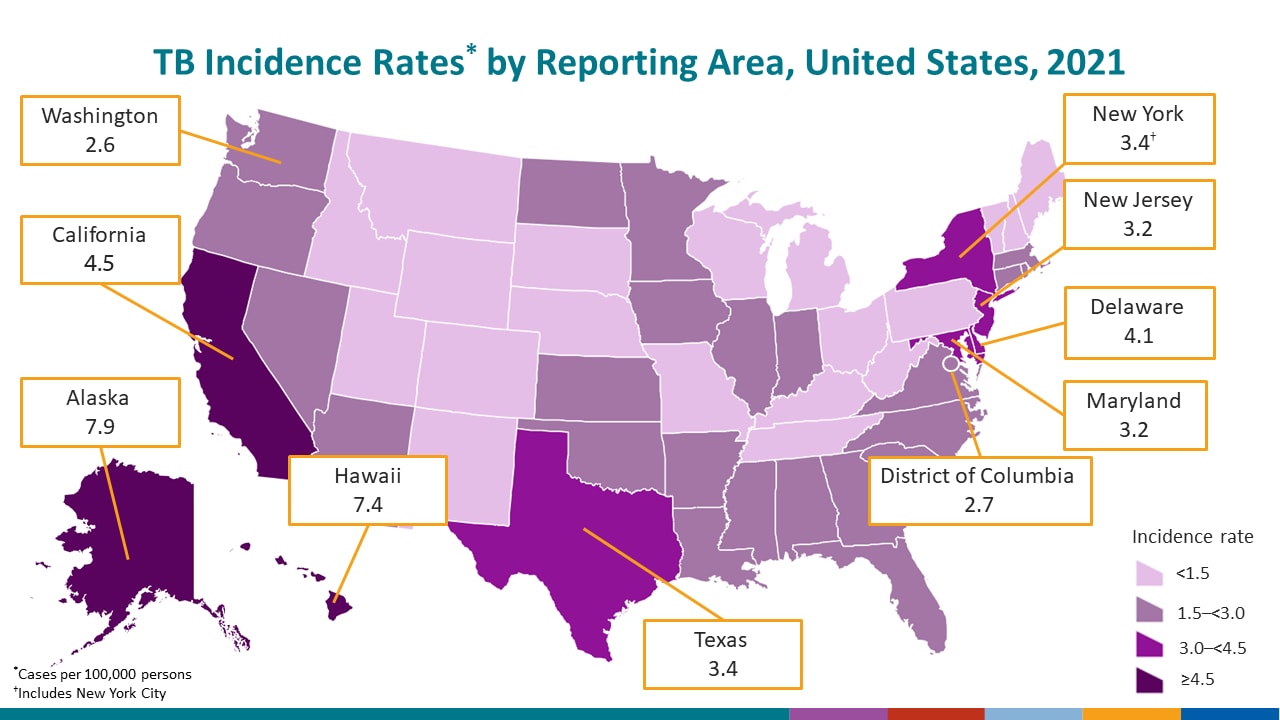Health Disparities in TB
TB bacteria are spread through the air from one person to another. When a person with TB disease of the lungs or throat coughs, speaks, or sings, TB bacteria can get into the air. People nearby may breathe in these bacteria and become infected.
Although anyone can get TB, some people are at greater risk of TB than others. This is because some population groups have higher rates of TB disease in their communities, thus raising the risk of becoming infected with the bacteria. Additionally, a range of social, economic, and demographic factors affect a person’s risk of TB disease. This section provides information on the prevention challenges for disproportionately affected groups and what CDC is doing to address them.
Racial and Ethnic Disparities
TB adversely affects groups that have historically experienced greater obstacles to health. The percentage of TB cases that occur in Hispanic or Latino, Black or African American, and Asian persons is higher than expected based on the percentage of these populations in the U.S. population. In 2021, 88.1% of the TB cases reported in the United States occurred among racial and ethnic minority groups. The percentage of TB cases occurring in non-U.S.–born persons was 71.4% of the national case total in 2021.
Medical Conditions
Certain medical conditions contribute to disparities in the rate of TB. Medical conditions such as diabetes, cancer, and HIV infection alter the immune system’s ability to fight TB germs. As a result, people with these medical conditions are more likely to develop TB disease if they are infected with TB germs.
Geographic Disparities
TB rates vary by geographic location across the United States. Nine states and the District of Columbia had incidence rates higher than the national rate of 2.4 cases per 100,000 persons in 2021:
- Alaska: 7.9
- Hawaii: 7.4
- California: 4.5
- Delaware: 4.1
- New York, including New York City*: 3.4
- Texas: 3.4
- Maryland: 3.2
- Jersey: 3.2
- District of Columbia: 2.7
- Washington: 2.6
*New York City, which is a distinct reporting area, had an incidence rate of 6.2 cases per 100,000 persons. When New York City is analyzed separately, the remainder of New York state has an incidence rate of 1.4 cases per 100,000 persons.
CDC monitors these geographic differences and provides funds to support TB prevention and control efforts in all states, as well as certain metropolitan areas with high rates of TB.
Because of the substantially greater risk of exposure to TB bacteria outside of the United States, origin of birth is the most prominent risk factor for TB disease in the United States. Consistent with previous years, the majority of reported persons diagnosed with TB disease occurred among non-U.S.–born persons (71.4%) in 2021.
Other Disparities
CDC surveillance efforts and research demonstrate TB disparities in relation to other factors such as housing insecurity and incarceration.
- TB and People Experiencing Homelessness
- TB and People Living in Correctional Facilities in the United States
Achieving Equity by Addressing Disparities
What CDC is Doing to Address Disparities in TB in the United States
CDC is committed to improving the health of people disproportionately affected by TB. To achieve TB elimination in the United States, ongoing efforts are needed to address the persistent disparities that exist. CDC is continuing to work on a series of projects designed to identify the underlying causes, as well as educate and raise awareness about health disparities in TB. This includes
- Collaborating with other national and international public health organizations to improve TB screening of immigrants and refugees, test recent arrivals from countries with high rates of TB, and improve TB control and prevention activities along the border between the United States and Mexico;
- Maintaining a Spanish TB website that provides Spanish-language TB information on exposure, testing, and treatment;
- Developing culturally appropriate patient education materials in English and other languages, and sharing through platforms like Find TB Resources;
- Supporting the TB Elimination Alliance, which brings together community-based organizations across the United States to increase knowledge, testing, and treatment of TB disease and latent TB infection among communities at increased risk for TB;
- Launching the first national multilingual communications campaign, Think. Test. Treat TB, which aims to reach those most at risk for latent TB infection and their healthcare providers to encourage TB testing and treatment;
- Highlighting the personal experiences of people who were diagnosed and treated for latent TB infection and TB disease, as well as the work of TB control professionals through personal stories;
- Compiling national reports of TB cases and TB case rates by gender, race and ethnicity, risk factors, and geographic location;
- Continuing the work of two CDC research consortiums to examine more effective TB treatment options and to study the risks of TB among persons with comorbid medical conditions;
- Engaging with healthcare providers to ensure they know about the latest TB diagnostics and latent TB infection treatment options available as well as engaging communities at increased risk of TB to raise awareness of TB and promote latent TB infection testing and treatment.
